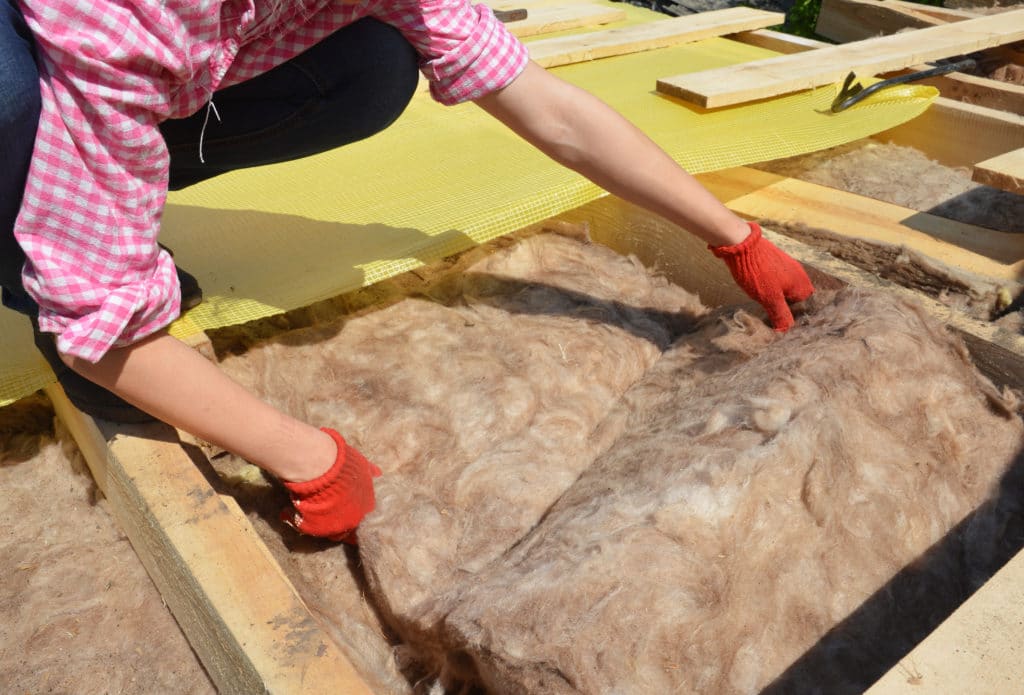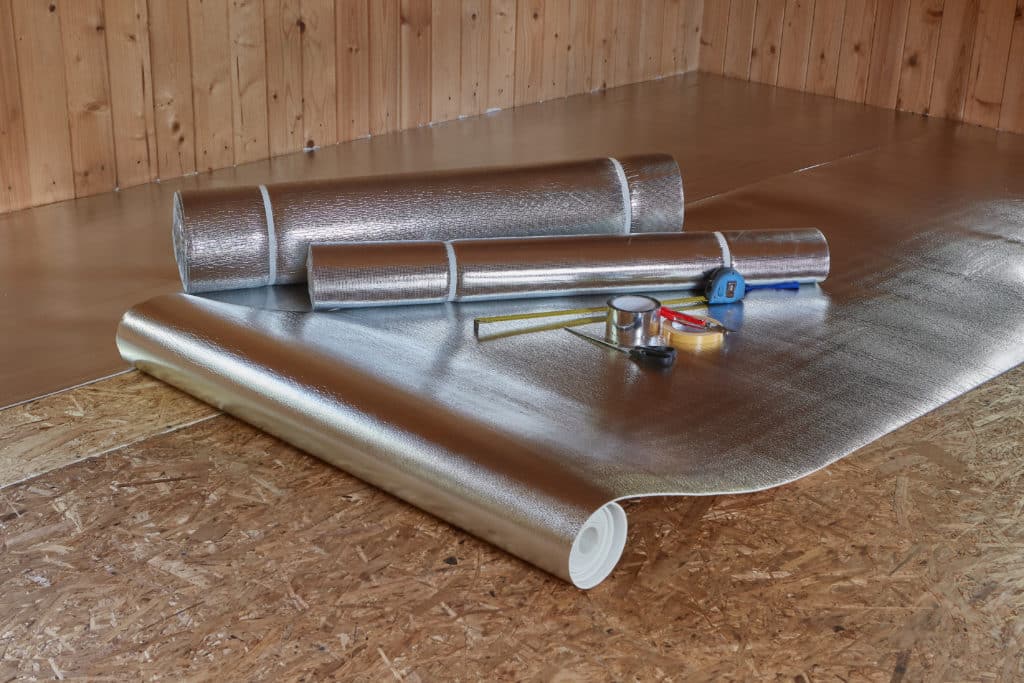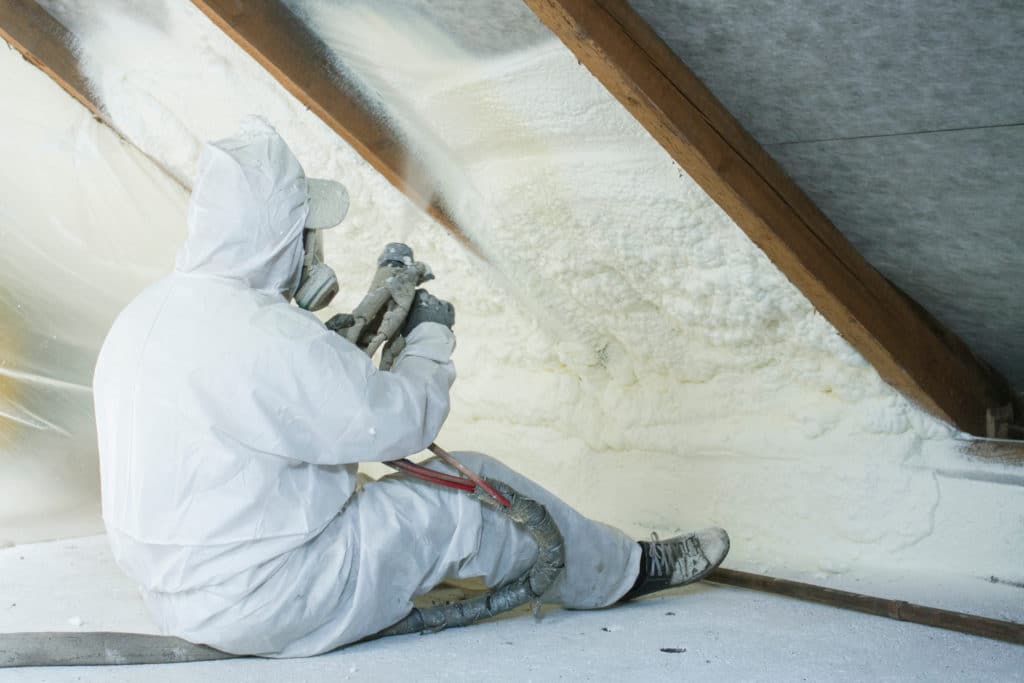How Much Does Insulation Cost?
Insulation is often considered a fairly expensive venture. However, when deciding whether to install any form of insulation, consider not only the cost but also the payback timescale. The savings on bills vary, so the payback also varies. We will discuss and compare the various types of insulation and their costs.
What types of insulation are there?
Insulation is crucial in the creation of a thermal envelope. As such, it can address all parts of your home. However, to accurately determine the payback and savings, we must consider the percentage of heat loss through different parts of your home. Due to several factors, your walls account for 35% of the heat loss. Firstly, walls present the largest surface area of the property. Therefore, there is a large area for the heat to pass through. Cold bridging is also a major issue around windows and doors, which are incorporated into the envelope. Lastly, the walls are the elements of the construction most exposed to the weather. The major problem with addressing this issue is that external wall insulation tends to cost the most.
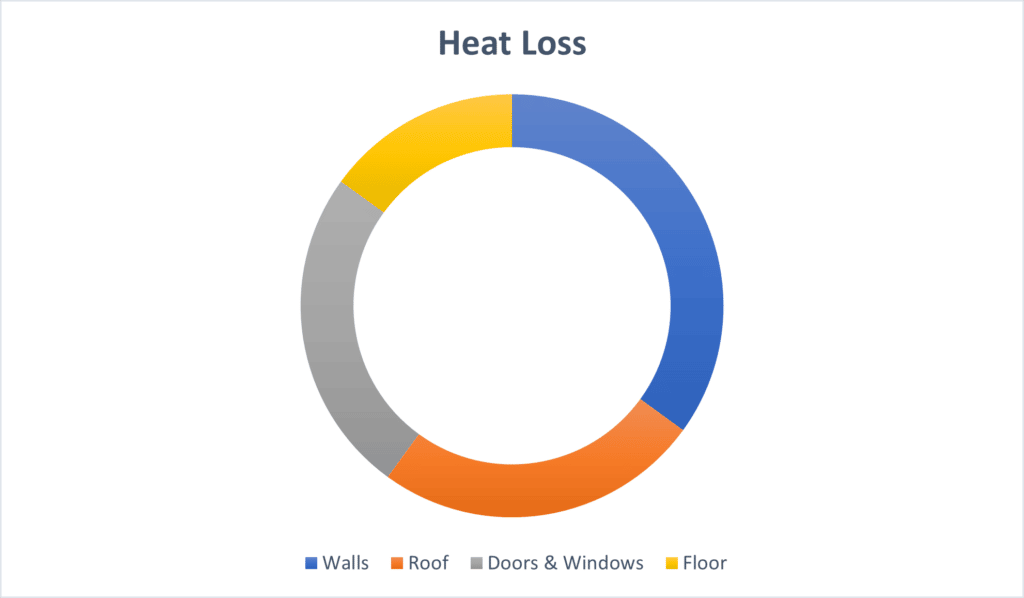
Types of insulation and cost
When we discuss insulation, we also focus on cold bridging. Therefore, it is crucial to consider draught prevention measures and window glazing as a part of the thermal envelope.
Prior to discussing the products, we need to establish the 4 forms of insulation:
- Loose-fill and blown-in Insulation are blown into open spaces and recommended for use in hard-to-reach areas like new wall cavities, existing walls, and attic floors and walls.
- Batt & Roll Insulation – Pre-cut slabs of insulation laid flat and fitted between studs, joists, and beams.
- Reflective Insulation and radiant Barriers – Installed in lofts to reduce the radiant heat transferred to below the ceiling. As a result, they are particularly useful in keeping houses cool.
- Spray Foam & Foam-In-Place Insulation – Injected into wall cavities, offering both thermal and acoustic insulation.
-
Loose-Fill & Blown-In Insulation -
Batt & Roll Insulation -
Reflective Insulation & Radiant Barriers -
Spray Foam & Foam-In-Place Insulation
Loose-fill/blown-in insulation and spray foam insulation always require a professional installer. However, roll and reflective insulation can, in theory, be installed by the homeowner. We always recommend a professional installer for any form of insulation. As a result, the costs will include the materials and labour.
Cost of insulation
The insulation cost will tend to depend on the square meterage of the area you hope to insulate. However, we have compiled some approximate figures for the cost of insulation. The crucial factor to consider is the other products you will require for an insulation system. External and internal wall insulation systems will require some form of adhesive, basecoat, reinforcing fibreglass mesh, and a finishing topcoat. We will detail these costs later on.
| Insulation type | Cost |
| Loose-Fill & Blown-In Insulation | £4.80 p/m² – £6.50 p/m² |
| Batt & Roll Insulation | £10/m² – £11/m² |
| Reflective Insulation & Radiant Barriers | £1/m² |
| Spray Foam & Foam-In-Place Insulation | £30/m² |
Insulation & thermal bridges
The table above details the approximate costs of the overarching categories of insulation. However, various types of materials are available for specific insulation systems. For example, at EWI Store, we offer Mineral Wool, EPS, and Kingspan K5. All of these come with different price points and require slightly different components in their overall systems.
As discussed earlier, components like window glazing and draught-proofing are included in the thermal envelope. These areas are particularly susceptible to cold bridging, as warm air always moves towards the path of least resistance. Gaps in an insulated thermal envelope provide ‘heat highways’ for the passage of heat energy, losing precious heat from your internal space. The cold bridge is created as the area in question will have a higher thermal conductivity.
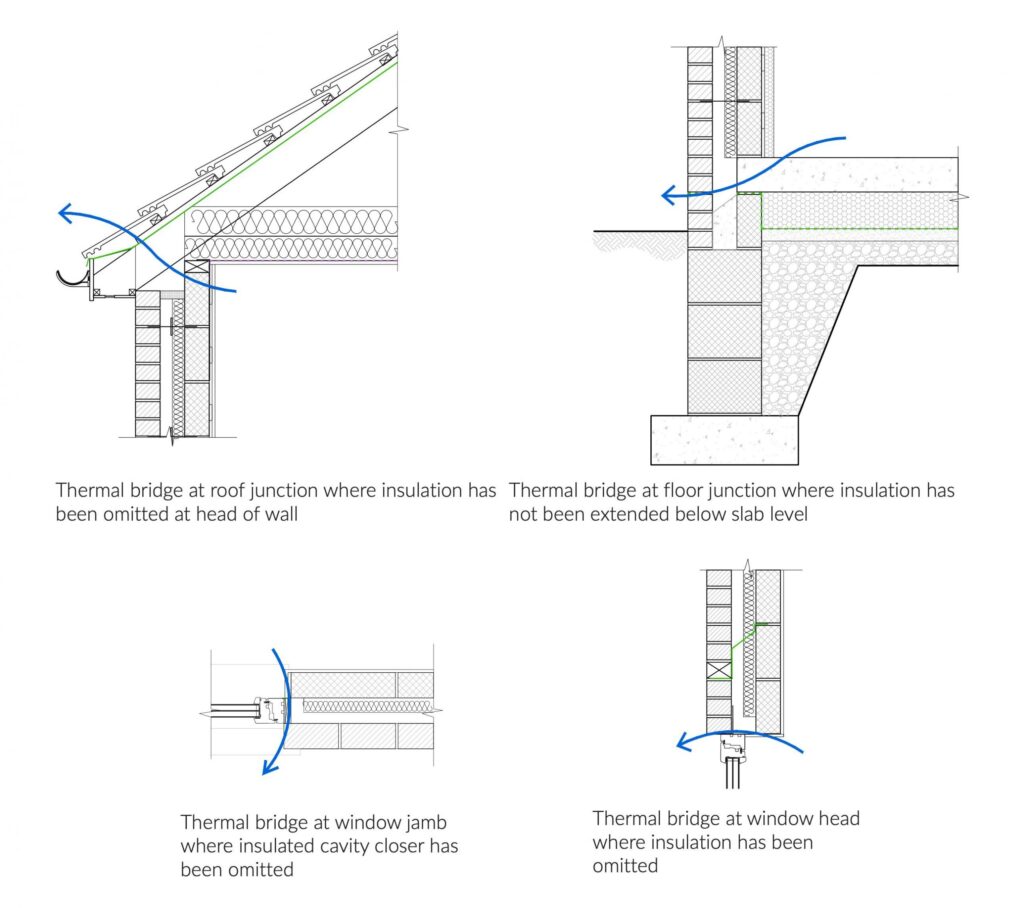
Thermal bridges can be classified into three main types (Leeds Beckett University: Low Carbon Housing Learning Zone):
- Repeating or quasi-homogeneous thermal bridges usually follow a regular pattern and are evenly distributed over an area of the thermal envelope
- Non-repeating or linear thermal bridges are often caused by discontinuities in the thermal envelope and occur at a specific point in the construction
- Geometrical thermal bridges are a result of the geometry or shape of the thermal envelope
Insulation materials and window glazing
The ultimate aim of any insulation project is to bring the U-value of your property down below the industry standard of 0.3 W/m2k for external walls. However, the figures differ for the roof at 0.15 W/m2k and 1.6 W/m2k for windows. Therefore, you need to consider a whole-house solution. Adding double or triple glazing to a Mineral Wool external wall insulation system would ensure that the industry standards are met, whilst also dealing with the issues of cold bridging. Windows and external wall insulation tend to be priced differently. Most window glazing options are priced per window, whilst insulation is priced per board or per square metre. You can see that detailed in the table below. The thickness of the insulation boards directly correlates to the thickness required to reach a U-value of 0.3 W/m2k.
| Cost | |
| Double glazing | £250 per window |
| Triple glazing | £505 – £770 per window |
| Rockwool | £21.50 ex VAT per board (110mm) |
| EPS | £8.25 ex VAT per board (90mm) |
| Kingspan K5 | £15.80 ex VAT per board (60mm) |
So, what’s the payback of insulation in relation to cost?
The savings and payback will vary dramatically depending on what you install and how large the home is. However, given what we know, we can make an educated guess on the savings and, from that, glean the payback timescale of the specific insulating product.
| Insulation type | Cost | Annual saving | Payback period |
| Cavity wall | £500 | < £140 | 4 years |
| Internal wall | £5,500 – £8,500 | £460 | 25 years plus |
| External wall | £9,400 – £13,000 | > £600 | 25 years plus |
| Loft | £300 | < £180 | 2 years plus |
| Floor | £530 | £60 | 13 years |
(Source: Energy Saving Trust website: http://www.energysavingtrust.org.uk/Insulation)
The cost of external wall insulation would initially come off as a significant hurdle. All these insulation forms have funding available through ECO4 and ECO Plus schemes; therefore, it is a worthwhile investment, as external wall insulation has the most significant impact on savings. The other funding available is through GBIS. The Great British Insulation Scheme is available for properties with an EPC below a C. Depending on the size of the house and other circumstances, GBIS can cover the cost of materials.
Altogether, it can be problematic to project the savings and payback timescale due to the numerous variables in play. For example, even if your thermal envelope is finished, it can still be susceptible to water ingress or thermal bridging.
Savings and payback can also change depending on the current cost of energy. There is a lot of uncertainty surrounding energy bills, with shortages affecting cost. However, certain measures and insulation can make cuts and savings.
Let us know how you plan to save money on bills and if you have any thoughts on how much insulation costs!
Facebook
Twitter
LinkedIn
Your cart
Trade Account Login

We use cookies on our website to give you the most relevant experience by remembering your preferences and repeat visits. By clicking “Accept All”, you consent to the use of ALL the cookies. However, you may visit "Cookie Settings" to provide personalised consent.
Manage consent
Privacy Overview
This website uses cookies to improve your experience while you navigate through the website. Out of these, the cookies that are categorized as necessary are stored on your browser as they are essential for the working of basic functionalities of the website. We also use third-party cookies that help us analyze and understand how you use this website. These cookies will be stored in your browser only with your consent. You also have the option to opt-out of these cookies. But opting out of some of these cookies may affect your browsing experience.
Necessary cookies are absolutely essential for the website to function properly. These cookies ensure basic functionalities and security features of the website, anonymously.
| Cookie | Duration | Description |
|---|---|---|
| __stripe_mid | 1 year | This cookie is set by Stripe payment gateway. This cookie is used to enable payment on the website without storing any patment information on a server. |
| __stripe_sid | 30 minutes | This cookie is set by Stripe payment gateway. This cookie is used to enable payment on the website without storing any patment information on a server. |
| _GRECAPTCHA | 5 months 27 days | This cookie is set by the Google recaptcha service to identify bots to protect the website against malicious spam attacks. |
| apbct_cookies_test | session | CleanTalk sets this cookie to prevent spam on comments and forms and act as a complete anti-spam solution and firewall for the site. |
| apbct_page_hits | session | CleanTalk sets this cookie to prevent spam on comments and forms and act as a complete anti-spam solution and firewall for the site. |
| apbct_prev_referer | session | Functional cookie placed by CleanTalk Spam Protect to store referring IDs and prevent unauthorized spam from being sent from the website. |
| apbct_site_landing_ts | session | CleanTalk sets this cookie to prevent spam on comments and forms and act as a complete anti-spam solution and firewall for the site. |
| apbct_site_referer | 3 days | This cookie is placed by CleanTalk Spam Protect to prevent spam and to store the referrer page address which led the user to the website. |
| apbct_timestamp | session | CleanTalk sets this cookie to prevent spam on comments and forms and act as a complete anti-spam solution and firewall for the site. |
| apbct_urls | 3 days | This cookie is placed by CleanTalk Spam Protect to prevent spam and to store the addresses (urls) visited on the website. |
| AWSALBCORS | 7 days | This cookie is managed by Amazon Web Services and is used for load balancing. |
| cookielawinfo-checkbox-advertisement | 1 year | Set by the GDPR Cookie Consent plugin, this cookie is used to record the user consent for the cookies in the "Advertisement" category . |
| cookielawinfo-checkbox-analytics | 11 months | This cookie is set by GDPR Cookie Consent plugin. The cookie is used to store the user consent for the cookies in the category "Analytics". |
| cookielawinfo-checkbox-functional | 11 months | The cookie is set by GDPR cookie consent to record the user consent for the cookies in the category "Functional". |
| cookielawinfo-checkbox-necessary | 11 months | This cookie is set by GDPR Cookie Consent plugin. The cookies is used to store the user consent for the cookies in the category "Necessary". |
| cookielawinfo-checkbox-others | 11 months | This cookie is set by GDPR Cookie Consent plugin. The cookie is used to store the user consent for the cookies in the category "Other. |
| cookielawinfo-checkbox-performance | 11 months | This cookie is set by GDPR Cookie Consent plugin. The cookie is used to store the user consent for the cookies in the category "Performance". |
| ct_checkjs | session | CleanTalk–Used to prevent spam on our comments and forms and acts as a complete anti-spam solution and firewall for this site. |
| ct_fkp_timestamp | session | CleanTalk sets this cookie to prevent spam on the site's comments/forms, and to act as a complete anti-spam solution and firewall for the site. |
| ct_pointer_data | session | CleanTalk sets this cookie to prevent spam on the site's comments/forms, and to act as a complete anti-spam solution and firewall for the site. |
| ct_ps_timestamp | session | CleanTalk sets this cookie to prevent spam on the site's comments/forms, and to act as a complete anti-spam solution and firewall for the site. |
| ct_sfw_pass_key | 1 month | CleanTalk sets this cookie to prevent spam on comments and forms and act as a complete anti-spam solution and firewall for the site. |
| ct_timezone | session | CleanTalk–Used to prevent spam on our comments and forms and acts as a complete anti-spam solution and firewall for this site. |
| elementor | never | This cookie is used by the website's WordPress theme. It allows the website owner to implement or change the website's content in real-time. |
| viewed_cookie_policy | 11 months | The cookie is set by the GDPR Cookie Consent plugin and is used to store whether or not user has consented to the use of cookies. It does not store any personal data. |
Functional cookies help to perform certain functionalities like sharing the content of the website on social media platforms, collect feedbacks, and other third-party features.
| Cookie | Duration | Description |
|---|---|---|
| __zlcmid | 1 year | This cookie is used by Zendesk live chat and is used to store the live chat ID. |
| bcookie | 2 years | LinkedIn sets this cookie from LinkedIn share buttons and ad tags to recognize browser ID. |
| bscookie | 2 years | LinkedIn sets this cookie to store performed actions on the website. |
| lang | session | LinkedIn sets this cookie to remember a user's language setting. |
| lidc | 1 day | LinkedIn sets the lidc cookie to facilitate data center selection. |
| UserMatchHistory | 1 month | LinkedIn sets this cookie for LinkedIn Ads ID syncing. |
Performance cookies are used to understand and analyze the key performance indexes of the website which helps in delivering a better user experience for the visitors.
| Cookie | Duration | Description |
|---|---|---|
| __utma | 2 years | This cookie is set by Google Analytics and is used to distinguish users and sessions. The cookie is created when the JavaScript library executes and there are no existing __utma cookies. The cookie is updated every time data is sent to Google Analytics. |
| __utmb | 30 minutes | Google Analytics sets this cookie, to determine new sessions/visits. __utmb cookie is created when the JavaScript library executes and there are no existing __utma cookies. It is updated every time data is sent to Google Analytics. |
| __utmc | session | The cookie is set by Google Analytics and is deleted when the user closes the browser. It is used to enable interoperability with urchin.js, which is an older version of Google Analytics and is used in conjunction with the __utmb cookie to determine new sessions/visits. |
| __utmt | 10 minutes | Google Analytics sets this cookie to inhibit request rate. |
| __utmv | 2 years | The __utmv cookie is set on the user's device, to enable Google Analytics to classify the visitor. |
| __utmz | 6 months | Google Analytics sets this cookie to store the traffic source or campaign by which the visitor reached the site. |
| sib_cuid | 6 months | Purechat uses this cookie to send data to purechat.com, to connect visitors to the reservation team and track visitors to stay on portal. |
| SRM_B | 1 year 24 days | Used by Microsoft Advertising as a unique ID for visitors. |
Analytical cookies are used to understand how visitors interact with the website. These cookies help provide information on metrics the number of visitors, bounce rate, traffic source, etc.
| Cookie | Duration | Description |
|---|---|---|
| _ga | 2 years | The _ga cookie, installed by Google Analytics, calculates visitor, session and campaign data and also keeps track of site usage for the site's analytics report. The cookie stores information anonymously and assigns a randomly generated number to recognize unique visitors. |
| _gat_gtag_UA_61069204_2 | 1 minute | Set by Google to distinguish users. |
| _gat_UA-61069204-2 | 1 minute | A variation of the _gat cookie set by Google Analytics and Google Tag Manager to allow website owners to track visitor behaviour and measure site performance. The pattern element in the name contains the unique identity number of the account or website it relates to. |
| _gcl_au | 3 months | Provided by Google Tag Manager to experiment advertisement efficiency of websites using their services. |
| _gid | 1 day | Installed by Google Analytics, _gid cookie stores information on how visitors use a website, while also creating an analytics report of the website's performance. Some of the data that are collected include the number of visitors, their source, and the pages they visit anonymously. |
| _uetsid | 1 day | This cookies are used to collect analytical information about how visitors use the website. This information is used to compile report and improve site. |
| CONSENT | 2 years | YouTube sets this cookie via embedded youtube-videos and registers anonymous statistical data. |
Advertisement cookies are used to provide visitors with relevant ads and marketing campaigns. These cookies track visitors across websites and collect information to provide customized ads.
| Cookie | Duration | Description |
|---|---|---|
| _fbp | 3 months | This cookie is set by Facebook to display advertisements when either on Facebook or on a digital platform powered by Facebook advertising, after visiting the website. |
| ANONCHK | 10 minutes | The ANONCHK cookie, set by Bing, is used to store a user's session ID and also verify the clicks from ads on the Bing search engine. The cookie helps in reporting and personalization as well. |
| fr | 3 months | Facebook sets this cookie to show relevant advertisements to users by tracking user behaviour across the web, on sites that have Facebook pixel or Facebook social plugin. |
| MUID | 1 year 24 days | Bing sets this cookie to recognize unique web browsers visiting Microsoft sites. This cookie is used for advertising, site analytics, and other operations. |
| NID | 6 months | NID cookie, set by Google, is used for advertising purposes; to limit the number of times the user sees an ad, to mute unwanted ads, and to measure the effectiveness of ads. |
| test_cookie | 15 minutes | The test_cookie is set by doubleclick.net and is used to determine if the user's browser supports cookies. |
| uuid | 6 months | MediaMath sets this cookie to avoid the same ads from being shown repeatedly and for relevant advertising. |
| VISITOR_INFO1_LIVE | 5 months 27 days | A cookie set by YouTube to measure bandwidth that determines whether the user gets the new or old player interface. |
| YSC | session | YSC cookie is set by Youtube and is used to track the views of embedded videos on Youtube pages. |
| yt-remote-connected-devices | never | YouTube sets this cookie to store the video preferences of the user using embedded YouTube video. |
| yt-remote-device-id | never | YouTube sets this cookie to store the video preferences of the user using embedded YouTube video. |
| yt.innertube::nextId | never | This cookie, set by YouTube, registers a unique ID to store data on what videos from YouTube the user has seen. |
| yt.innertube::requests | never | This cookie, set by YouTube, registers a unique ID to store data on what videos from YouTube the user has seen. |
Other uncategorized cookies are those that are being analyzed and have not been classified into a category as yet.
| Cookie | Duration | Description |
|---|---|---|
| _clck | 1 year | No description |
| _clsk | 1 day | No description |
| _uetvid | 1 year 24 days | No description available. |
| AnalyticsSyncHistory | 1 month | No description |
| apbct_pixel_url | session | No description |
| apbct_visible_fields_0 | session | No description |
| apbct_visible_fields_1 | session | No description |
| apbct_visible_fields_10 | session | No description |
| apbct_visible_fields_2 | session | No description |
| apbct_visible_fields_3 | session | No description |
| apbct_visible_fields_4 | session | No description |
| apbct_visible_fields_5 | session | No description |
| apbct_visible_fields_6 | session | No description |
| apbct_visible_fields_7 | session | No description |
| apbct_visible_fields_8 | session | No description |
| apbct_visible_fields_9 | session | No description |
| ct_checked_emails | session | No description |
| ct_has_scrolled | session | No description |
| ct_mouse_moved | session | No description |
| ct_screen_info | session | No description |
| ictf_master | never | No description available. |
| li_gc | 2 years | No description |
| m | 2 years | No description available. |
| SM | session | No description available. |
| testinfinitycookie | session | No description |
| woocommerce_show_tax | 7 days | No description available. |
| wp_woocommerce_session_c5ac76b408021294cb56bcc27eddf8a1 | 2 days | No description |



